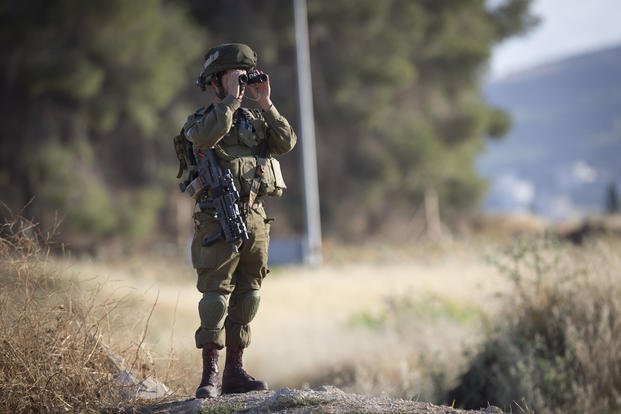The opinions expressed in this op-ed are those of the author and do not necessarily reflect the views of Military.com. If you would like to submit your own commentary, please send your article to opinions@military.com for consideration.
Last Saturday's attack by Hamas out of Gaza has led many to wonder at the failure by the vaunted Israeli intelligence services to anticipate the violence. Successful strategic attacks do not just happen. They generally involve three key elements. All require months or years of preparation before conflict commences.
The first is to lull the enemy into a false sense of security. There is truth in the old western movie cliché, "It's too quiet out there." Making the intended victim believe that his basic system of deterrence is working is generally critical for the surprise to be successful.
In 1973, both Egypt and Syria toned down their harsh rhetoric against Israel in the months leading up to the Yom Kippur War. In 1941, the Japanese continued to negotiate with the Americans literally up to the day before the attack on Pearl Harbor. The Japanese Navy ceased most critical communications in the weeks leading up to the attack. What the Americans heard from Japanese naval radio stations were administrative communications indicating that most of the fleet was at home, when it was in fact sailing east in radio silence.
In the months leading up to last week's attack, several Israeli commentators noted how quiet Hamas and Islamic Jihad had become, with the assumption that deterrence was working and that the two rivals were engaged in internal rivalry.
A second rule is to let the enemy see what he wants to see. In the years leading up to the Yom Kippur War, the Egyptians and Syrians held regularly scheduled autumn exercises in which they massed forces along the Suez Canal and Golan Heights respectively, and then demobilized. When the exercises commenced in 1973, the Israelis thought they were seeing business as usual.
Likewise, the Mongol attack on the Muslim Khwarazmian Empire in 1220 A.D. was wrapped in deception. Genghis Khan himself personally led what we would now call a diversionary force along the expected east-west avenue of approach, simulating a much larger force. Meanwhile, Subutai -- his most trusted general -- was moving through the Kyzylkum Desert to the north with the main striking force. When Subutai struck the strategic city of Bukhara from an unexpected direction, the result was a shattering surprise.
In their Gaza-launched attack, the Palestinians followed this formula. Rather than try to import conventional heavy military equipment from Iran that the Israelis would have spotted immediately, Hamas used civilian equipment on hand. Bulldozers, pickup trucks and motorcycles are ubiquitous in the Gaza Strip, as are the motor launches used for the amphibious portion of the attack. Even the motorized hang gliders used in the assault would not be unexpected along Gaza's recreational beaches.
A final essential element for strategic surprise is secrecy through compartmentalization at the strategic, operational and tactical levels of war. This is much easier to achieve in authoritarian regimes where the press is tightly controlled. For them, "need to know" really means need to know. In 1973, Egyptian and Syrian front-line soldiers believed that they were on a routine peacetime exercise until they were issued live ammunition.
Although not an absolute requirement, it helps if the population of the attacking party has real or perceived grievances, and the targeted opponent is disunited. In 1940, the French were badly politically split over support of a Poland that had already been destroyed. Even the French Communists were divided among those who blindly followed the Soviet party line and those who were disillusioned that Stalin would join Hitler in carving up Poland.
Likewise, prior to Pearl Harbor and 9/11, the United States was deeply divided. What Japanese Prime Minister Hideki Tojo and Osama bin Laden underestimated was how quickly the American people would come together in a quest for revenge and justice for what they regarded as a sucker punch.
Hamas and Islamic Jihad struck Israel at a time of deep division over its judicial crisis. It remains to be seen if the events of Oct. 7 will unite or further divide Israel.
It also helps if the attacker has clear strategic goals as part of its objective. The objective of the attackers in 1973 was to recapture some of the honor lost in the 1967 Six-Day War, and seize ground lost to the Israelis in that conflict. In the case of the Sinai Peninsula, the Egyptians eventually accomplished both, while the Syrians achieved only the first. In attacking on 9/11, al-Qaida clearly hoped to become the major anti-western Jihadist group and bring down the U.S. economic system. The second proved to be a bridge too far, as did the hope of the Japanese to force a negotiated settlement with the U.S. post-Pearl Harbor. As Japanese Adm. Isoroku Yamamoto predicted, the surprise was fleeting.
Hamas and Islamic Jihad clearly have the twin goals of refocusing world attention on the grievances of the Palestinians and forcing Israel to the bargaining table over the fate of its hostages.
Strategic surprise is a high-risk gamble effort with a potentially high payoff, but when it goes wrong, it can go terribly wrong. Regarding the ongoing conflict, time will tell.
-- Gary Anderson was the director of Marine Corps war gaming and was a senior executive of the Defense Adaptive Red Team project. He lectures on Red Teaming at the George Washington University's Elliott School of International Affairs.











